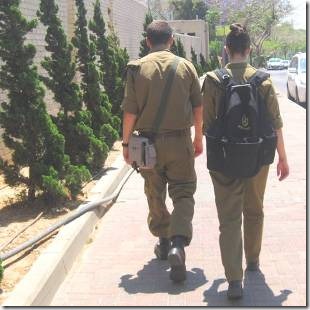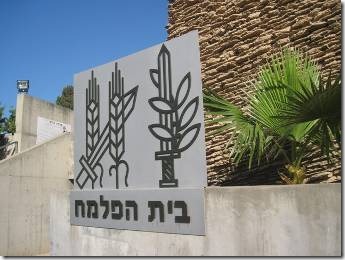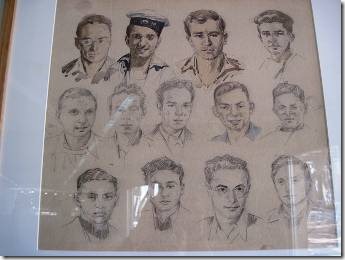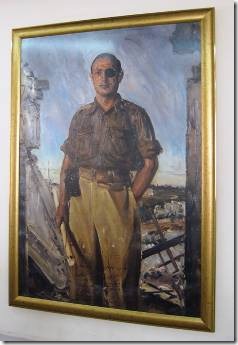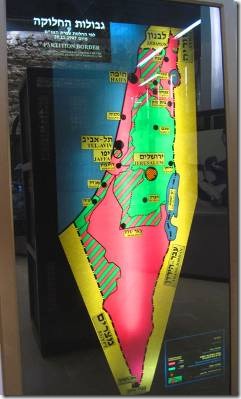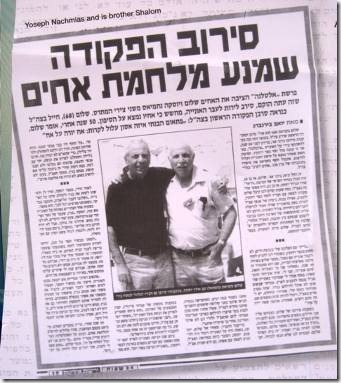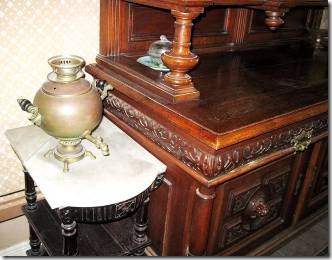May 31, 2012
Ashdod Marina
Israel
Shalom from Ashdod,
Yesterday we rolled our way to Ashdod, as in roll to the port side then roll to the starboard side, then roll to the port side, then starboard, then port, then starboard from when we left Herzliya just past 8 am until about noon when we arrived in Ashdod. I took a preventive sea sick pill ( after being on land for a month I need a bit of help with my sea legs) and so I was fine. I can’t say that about everyone. But it all worked out. I drove most of the way, but it was simple because we just drove south with land on our port. Randal drove past the big Port of Ashdod with the huge cargo ships were anchored and then into the marina. Our friend Eve and marina manager Yoram Greenberg were there to catch our lines. Instantly DoraMac attracted attention and right after lunch I gave a boat tour while Randal attached a new plug to our power cord so we could plug into the marina power source.
After an afternoon rest, Linda, Charmaine and I walked the 15 minutes to an area with an Art Museum and Center, mall and supermarket. On Wednesday there is an open market that we will visit next week. It is just a walk down the beach.
So that’s it.
Ru
I honestly can’t keep the different parts that eventually came to make up the Israel Dense Forces straight. What I will always remember about the IDF are the young, khaki-uniformed Israeli “soldiers.” You see them everywhere. “Because of Israel’s small size, soldiers often travel from front to home, a commute that is rarely more than two hours.” The Israelis by Donna Rosenthal. And I’ll remember coming into Israel and having to answer questions over the VHF radio to prove we weren’t enemy. But they weren’t scary people over the radio nor when we got to the Herzliya Marina and had to answer more questions. What was the hardest question to answer in a way they could understand, and they never did, was that I had no family or friends in Israel, had never been before, and wasn’t planning to move permanently. And the Israeli Naval ship, docked across from us at the marina, that broadcasts pop music at night and what sounds like prayers in the morning.
They look like kids on their way to a college class, and it the US they very well would be. In Israel right after high school comes military service; boys serve 3 years and girls 2. I saw them while I was walking in Tel Aviv from the Diaspora Museum to the Eretz Israel Museum several weeks ago.
History:
The IDF was formed out of a number of armed groups which operated before 1948. The Haganah (Defense), the semi-legal defense organization of the Jewish Yishuv in Palestine, was established in 1920 to defend Jewish settlements from Arab attacks. During the Arab Revolt which began in 1936, differences of opinion emerged within the Haganah regarding defense policy. While the Haganah followed a policy of restraint and carried out only defensive actions, those who called for retaliatory measures broke off in 1937 to form the Irgun Zvai Leumi (National Military Organization) or IZL. When the IZL decided to cooperate with Britain after the outbreak of the Second World War, a small group seceded and created the Lochamei Herut Israel (Freedom Fighters for Israel) known as the Lechi. During the spring of 1941, the Haganah formed the Palmach (Striking Companies), a mobile force of full-time soldiers, in order to assist the British in defending Palestine from Rommel’s offensive which by this time had reached the borders of Egypt. These various forces, which continued to exist until 1948, maintained separate political allegiances. The Haganah, formed by the Histadrut (the Jewish Federation of Labor) and taken over by the Jewish Agency after the Arab riots of 1929, enjoyed the widest support within the Yishuv. The IZL had close connections with the non-socialist Revisionists and most of the Palmach leadership was associated with Achdut HaAvoda, the Labor Party’s primary rival from the left. The Lechi included individuals from across the political spectrum who were united by their support of an unrelenting struggle against the British administration in Palestine. On May 26, 1948, the Israeli Provisional Government issued Order No. 4 which established the Israel Defense Forces and explicitly prohibited the maintenance of any other armed forces within the territory of the state. During the following months, the IZL, the Lechi and the Palmach were absorbed into the IDF, which became a non-political, tightly controlled and centralized body. http://www.jewishagency.org/JewishAgency/English/Jewish+Education/ Compelling+Content/Eye+on+Israel/Society/9)The+Role+of+the+Military +in+Israel.htm
Randal and I visited the Palmach Museum, the Etzel Museum and the Hagana Museum all museums dedicated to the history and importance of these military/defense organizations to the existence of Israel. My favorite was the Palmach Museum where you “joined” a group of new recruits in Palestine and remained with them through their training and through the battles of 1948. Some of them lived, some were wounded and some were killed. It was a very moving exhibit done through a series of videos as you moved from location “sets” through the museum watching their lives unfold.
House of the Palmach…The Palmach Museum
Artist Ludwig Blum’s son and 12 fellow soldiers were killed attempting to destroy a British bridge in 1946. Blum’s portrait of Moshe Dayan 1949
Ludwig Blum
Blum served in the Austrian army in WWI, a war in which his older brother was killed. A fervent Zionist, he moved to Israel in 1923. His eldest son was killed in a military operation in 1946; Blum himself served in the civil guard in 1947–48, remaining in Jerusalem throughout the War of Independence. During the war, Blum made a series of portraits of Jewish freedom fighters, all wearing the firm but emotionally restrained expression that Blum projected onto his canvases. http://www.jewishideasdaily.com/content/module/2011/12/15/main-feature/1/the-stoic-vision-of-ludwig-blum
While I’m writing about the Palmach, I’m going to include a former member who most of the world knows for a totally different reason than the defense of Israel; Vidal Sassoon.
“In 1948, as the British Mandate was drawing to a close, Sassoon arrived in Palestine where he joined the Palmach in the fight for Israel’s independence. In the manner of the young men and women who had flocked to Spain in the previous decade to fight on the Republican side during the Civil War, Sassoon’s decision to participate in the Zionist struggle for independence, like that of the other volunteers who came from Europe and America, was rooted in a commitment to Jewish pride and honor.
“That was the best year of my life,” Sassoon later told a British newspaper. “When you think of 2,000 years of being put down and suddenly you are a nation rising, it was a wonderful feeling. There were only 600,000 people defending the country against five armies, so everyone had something to do.” Sassoon served in combat. “I wasn’t going over there to sit in an office,” he told the Jewish Chronicle. “I thought if we don’t fight for a piece of land and make it work, then the whole Holocaust thing was a terrible waste. But this way at least we got a country out of it.”
http://www.tabletmag.com/jewish-news-and-politics/99345/vidal-sassoon-streetfighter
The next two military museums we visited were the ETZEL Museum and the Hagana Museum this past Monday.
Center Israel Tours:
Etzel Museum -Tales from the underground
By: LYDIA AISENBERG Photo : LYDIA AISENBERG
The Etzel Museum in Tel Aviv tells of heroic battles against the British and Arabs, but also the chilling story of Jews fighting Jews.
With the green lawns of the Charles Clore Park on three sides and the azure waters of the Mediterranean on the fourth, the stone and black glass Etzel Museum building on the Tel Aviv shoreline is certainly impressive. A blue cloudless sky and attractive layered Jaffa skyline in the near distance are additional factors making the museum building stand out – while at the same time somehow blending in with its surroundings.
An enormous Israeli flag flaps high in the sea breeze above the museum, built over the ruins of a former Ottoman-period building. The museum is dedicated to the memory of operations officer Amihai (Gidi) Paglin and 41 fighters of the pre-state paramilitary Etzel (an acronym for Irgun Zvai Leumi, or National Military Organization) who fell in the campaign to conquer the nearby Arab town of Jaffa, and also documents other battles that Etzel members fought in during the 1947-8 War of Independence.
Active in Palestine from 1931 to 1948, the Jewish underground organization retaliated against attacks by Arabs on the Jewish population and rebelled against the British government’s ‘White Paper’ policy that imposed restrictions on Jewish immigration to Palestine.
The integration of the Etzel fighters into the newly-formed Israel Defense Forces (IDF) was brokered in an agreement signed between then-I.Z.L. Commander-in-Chief Menachem Begin and Israel Galili on behalf of the government of Israel. But even after the agreement was signed, there remained a great deal of bitterness between Begin and Ben-Gurion and their supporters, much of which centered around the June 1948 Altalena affair when Palmah soldiers attacked an arms-carrying Etzel ship close to the Tel Aviv shore.
The Etzel Museum on the Tel Aviv beachfront belongs to the Museums Unit of the Ministry of Defense, which explains the four “girl soldier-guides” manning the reception desk. The day Metro visited, the museum was empty, apart from the soldiers and a young security guard – which on the one hand was useful as nobody got in the way of photographs or obliterated the prolific texts alongside exhibits, but on the other was a little eerie.
On the beach immediately across the promenade from the museum a few dozen mostly young Israelis sunbathed or rode surfboards close to the shore. A foreign television crew was busy setting up equipment in the shade at the side of the building, as a municipal worker attempted to clean the pathway around them. (Same when we went, empty except for an auditorium full of soldiers and some who, on their cell phones, yakked it up where we were watching the video so an older, museum man told them to be quiet. We bought senior tickets, and paid the extra 5 shekels for the “Military Museums group ticket. There was a mix of Hebrew and English at the displays and they switched the video about Etzel history to English when I thought to ask. )
The first portion of the museum deals with the organizational structure of the Etzel. A map of Israel according to the UN partition resolution of November 29, 1947 is displayed on one wall, alongside another map with the boundaries of Israel following the armistice agreements of July 1949.
1947 Map (my photo)
The map is accompanied by explanations and documents of the Etzel’s response to the partition plan and the hostilities that broke out after the plan was announced.
A model of steel helmeted soldiers defending their post, surrounded by sandbags and barbed wire, greets the visitor on the first corner turned in the museum, set out in serpentine fashion. An electronic map serves as an introduction to the entire exhibit showing Etzel positions, attacks and raids and the capture of Arab villages during 1947 and 1948, including the infamous attack on the village of Deir Yassin in the Jerusalem corridor. Maps, documents and photographs are on display as well as a diorama presenting the heroism of two Etzel women fighters, who chose death over surrender, in the battle for Yehudiya.
Up on the next floor one finds a description of the attack on Ramle. Fifty-one Etzel fighters died in the battle and many were wounded. On the same floor an area focuses on the fighters’ training and purchase of arms, as well as somewhat tongue-in-cheek details of the ‘requisitions’ of British ammunitions, which included 20,000 81mm mortar bombs swiped from a British train transporting ammunition to Arab fighters in Gaza.
Following the infiltration of a British army camp near Pardess Hanna, Etzel fighters also ‘requisitioned’ weapons, ammunition and an armored vehicle from the British paratroopers stationed at what is today a large IDF training base known as Mahane 80 on the main Wadi Ara highway.
A large exhibition is dedicated to battles waged in the liberation of Jerusalem, and operations with the pre-state Haganah and Lehi militias. Two interesting dioramas deal with a stronghold of the British in the city, Zion Gate and in the background, the Old City of Jerusalem.
Another section concentrates on operations in the north such as the battle at Mishmar Hayarden, cooperation between forces of the Haganah and Etzel in the defense of Safed, and the taking of the Wadi Nisnas Arab neighborhood in Haifa – in present times the venue for an annual co-existence festival of art, music and culinary delights held during the month of the Hannuka, Christmas and Ramadan holidays.
The last section of the museum deals with the Altalena incident. The Etzel’s armaments-carrying ship had embarked from the port of Marseilles. Upon arrival at the shore of the newly-founded State of Israel opposite Kfar Vitkin, Ben-Gurion’s demands that the armaments be handed over to the unified Jewish forces were refused. An attack on the ship was ordered, and a massive explosion set off by a shell destroyed the ship and cargo.
So what did I learn from visiting the military museums? For the most part, Jews pretty much only had themselves to depend upon. That the people who came to Palestine and worked to make it into the State of Israel have a great deal to be proud of. That the military museums in Israel make you see that it’s really as much the story of people as weapons and artillery. That Israel is a huge success story given all it has had to fight against. What they don’t talk about is how to make peace. And I don’t remember seeing any mention of help from American Jews. But then military museums are for boasting about a country’s military history and success. I found myself getting stuck again with what to write. Going to the military museums was a bit like going to Jerusalem, just feelings. How half of the military struggle was to smuggle Jews out of refugee detention camps in Europe and Cyprus and smuggle them into Israel. The Exodus movie is based on a true story. So anyway, I’m going to slap my hands together as our friend Eve does and say, “it’s finished.”
“I was with my regiment in Givat Haim….when I was ordered to arrive a the shore to intercept a boat carrying weapons. I asked, whose boat is that? Just a boat, they told me. What boat? I insisted, finally they told me it was an Etzel boat. I said I could not possibly fight against it. Are you disobeying orders? They demanded. I said, definitely! I have a brother in the Etzel and they might be there. What do you want, for me to kill them? That a man will fire on his brother?…” Shalom and several others who would not fire, were arrested. “A few days later,” Shalom tells, “they brought us before three judges…I was asked, ‘will you die for your country? Fighting its enemies?’ I told them the Etzel and Lehi were not the country’s enemies. Later they let us go”.. from an Etzel Museum handout.
The exhibit dealing with the Altalena is the last section of the museum. A large encased flag of Israel, flown on the deck of the Altalena, hangs on the wall. In the accompanying text one reads that the flag was saved minutes before the ship blew up, an Etzel fighter risking life and limb in an effort to rescue it.
Under a model of the ship, photographs and additional text, a large white lifebelt from the ship is propped up against the wall, the name ALTALENA silently shrieking of the tragic circumstances that brought Jews to battle Jews in the State of Israel – appropriately memorialized in a museum just meters from the sea. http://www.jposttravel.com/center_tours/etzel.html?image.x=23&image.y=6
Our final military museum was the Hagana Museum which we visited because we’d bought that “group ticket” and because we passed by it going somewhere else. By that point we were military museumed out. http://www.hagana.co.il/show_item.asp?itemId=54&levelId=60321&itemType=0 is the official site of the Hagana.
“Hagana was founded in 1920 to defend the Jewish community in Palestine against Arab violence. It fought and repelled murderous attacks in 1920,1929 and throughout the Arab rebellion in 1936-1939. In the Second World War Hagana was deployed to fight an eventual German invasion. It also mobilized 30,000 to fight with Britain against the Nazi enemy, and participated in the conquest of Lebanon and Syria. After the war Hagana launched in Palestine a civilian and armed struggle against the British authorities, which blocked immigration of Holocaust survivors and banned new Jewish settlements”
Personalizing history: seeing Eliahu Golomb’s somavar made me think of the one we had at home so that’s the photo I took away from the Hagana Museum.
A somavar in the home of Eliahu Golomb, the founder and leader of the Hagana who lived there and operated from it until his death 11 6 1945. His house served as the central headquarters for the Haganah.
The Hagana Museum describes the horrors of the situation in the country on the eve of the formation of the Hagana organization, the activities of the organization in the efforts to get a Jewish state, the development of the organization and its achievements. The main exhibition is arranged according to thirty subjects, tracing Israel’s defense history from 1878, when the first "shomrim" or watchmen were organized to protect the early settlers, through the Haganah’s establishment in June 1920, the quelling of disturbances in the 1920’s and 30’s, and the struggle against the British authorities up to the War of Independence. http://ilmuseums.com/museum_eng.asp?id=61
The Hagana Museum on Rothschild Avenue is the central museum for the history of the Hagana, the Jewish military organization for the defense of the Jewish settlements during the time of the British Mandate in the Land of Israel. The Hagana Museum is housed inside one of Tel Aviv’s first houses which served as the central headquarters for the activity of the Hagana Organization. The Hagana Museum spreads over three floors and tells the story of the development of the central defense force of the Jewish settlement during the British Mandate. At the Hagana Museum are displayed a collection of weapons, documents, photographs and certificates, which describe the history of the organization- its first days and its great importance for the defense of the Jewish settlements during the Arab attacks, the foundation of the Jewish "Tower and Stockade” settlements, the Jewish clandestine immigration into Israel, the Jewish War of Independence, the foundation of the State of Israel and the Israel Defense Forces. The house in which the Hagana Museum is housed used to be the home of Eliyahu Golomb, one of the founders and leaders of the Hagana and is also considered an architectural gem. It has illustrated tiles, stone carpets and decorated walls. In two of the rooms the original furniture remains and one can learn from it about the way of life of the time in old Tel Aviv. The Hagana Museum named after Eliyahu Golomb belongs to the Museums Unit of the Israeli Ministry of Defense.

